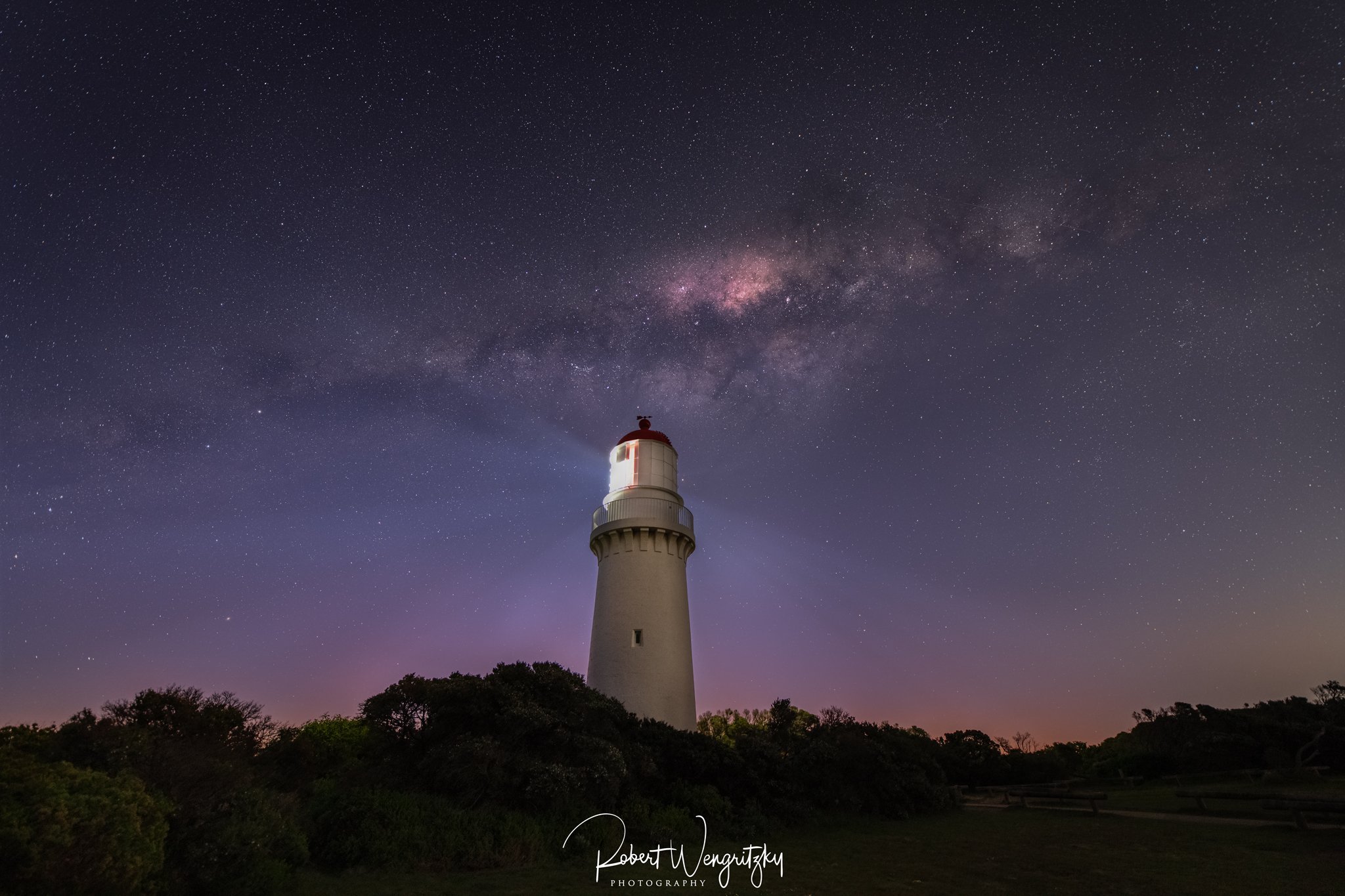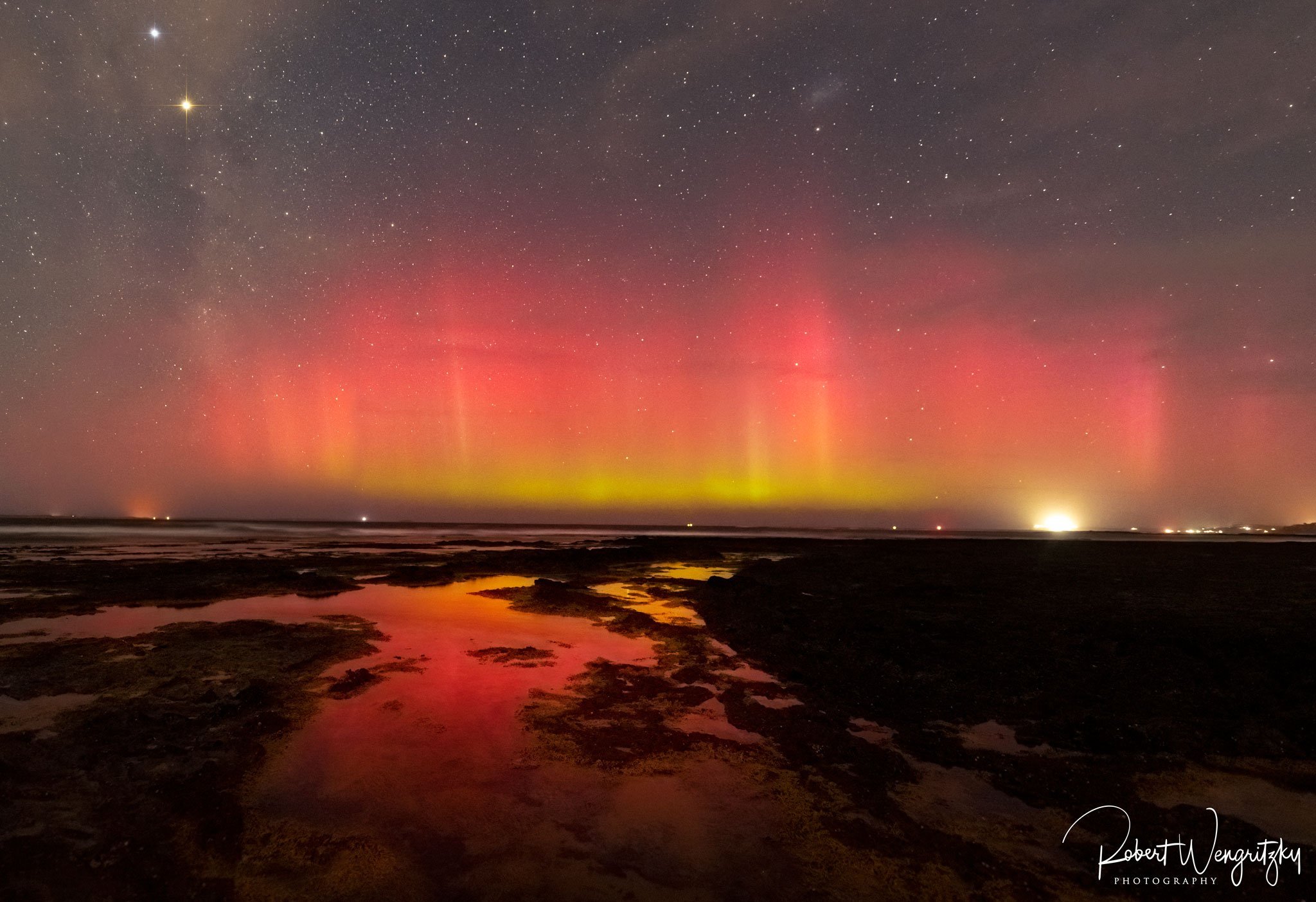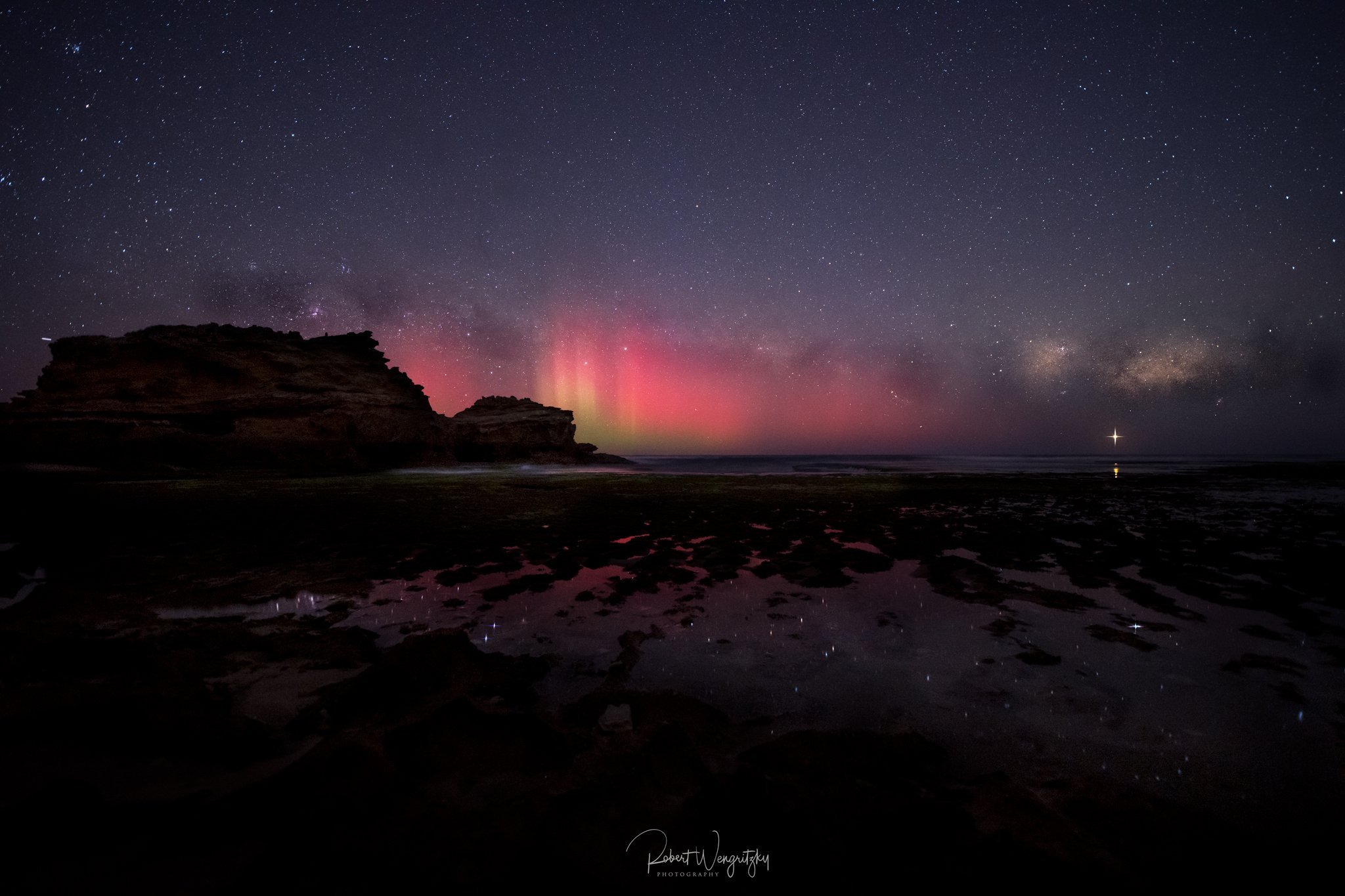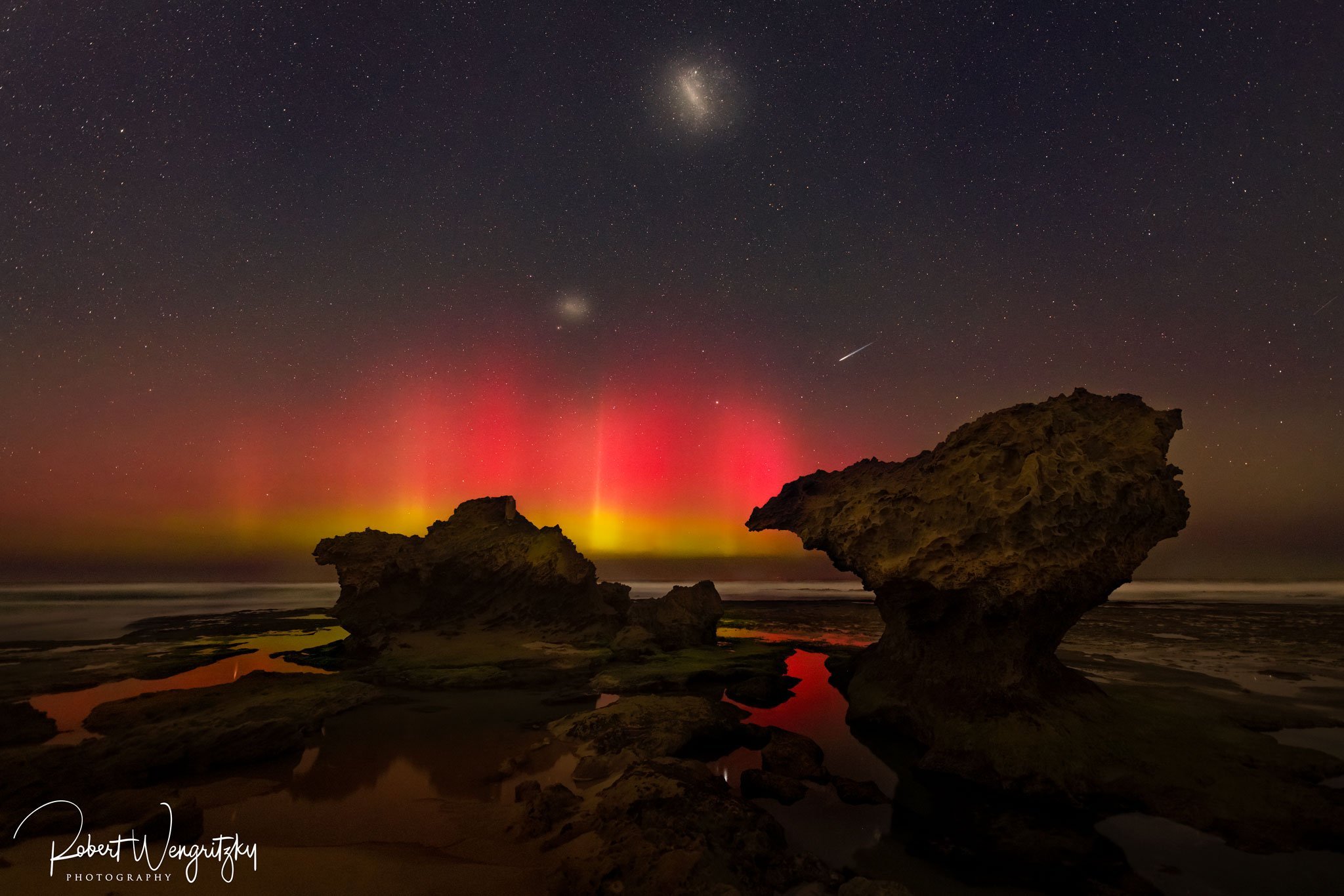Best Locations for Viewing the Aurora Australis in the Mornington Peninsula
While the Mornington Peninsula is not as far south as Tasmania or New Zealand, it still offers some great spots for viewing the aurora australis under the right conditions. The rugged coastline of the Peninsula has many hidden gems in terms of viewing and shooting locations, which I’ve spent many years exploring and enjoying. One of the most common questions I get asked is “where can I see the aurora?!”, so I thought today I’d write a handy list you can refer to with some of the spots I’ve found where you can see the aurora.
Nighttime Photography Etiquette
Before I start, a quick word on some tips and safety to ensure a pleasant experience for everyone and to capture the best possible images. Unfortunately, when there is a news story that an aurora is likely to happen and be visible, everyone flocks to the more common locations and it can be harder to see or photograph the aurora when it gets too busy.
Minimize Light Pollution:
Avoid using bright white lights. If you have one, use a red light flashlight or headlamp to preserve your night vision and avoid disturbing others.
Turn off or cover any unnecessary lights on your equipment. Avoid using bright screens on phones or cameras. Dim your screens and use screen protectors to reduce light emission.
The more light there is, and the more you lose your night vision, the less visible the aurora will be.
Be Mindful of Others:
Keep noise levels down. Voices carry further at night and can disrupt the serene atmosphere.
Respect other photographers' space. Avoid walking into their shots or shining lights in their direction.
If you need to move through someone's setup, communicate your intentions politely and ask for guidance on where to step to avoid disrupting their work.
Avoid Flash Photography:
Flash can ruin long exposures and timelapses for other photographers. Only use flash if absolutely necessary and ensure no one else is shooting nearby.
Stay on Designated Paths:
Stick to established trails and paths to avoid damaging sensitive environments and to prevent accidents.
Pack Out What You Pack In:
Leave no trace. Take all your rubbish with you, including food wrappers, batteries, and other disposables.
Be Prepared:
Arrive early to set up your gear and familiarize yourself with the surroundings in daylight if possible.
Respect Time-Lapse Setups:
If you notice another photographer is capturing a time-lapse, be extra cautious about not shining any lights in their direction or walking in front of their camera.
Stay Safe:
Always prioritize safety. Be careful where you venture in the dark, stay warm and drive safe! During the last large aurora, there were 7 accidents and some quite serious as everyone rushed down the Mornington Peninsula to see the lights
Best Locations for Viewing the Aurora Australis in the Mornington Peninsula
1. Cape Schanck
Why It's Great:
Located at the southern tip of the peninsula, providing clear views to the south.
Rugged coastline and the iconic lighthouse offer great foreground elements.
Easy access with the boardwalk
Carpark somewhat hidden so that arriving cars won’t ruin your photos
Tips:
Explore the boardwalk and trails to find a perfect spot with a good view of the southern sky.
Be cautious of cliffs and rough terrain, especially at night.
Can get very, very busy during big aurora alerts. Potentially one to stay away from if you’ve seen a news story about the aurora as it will be crowded!
Cape Schanck has some fantastic foreground elements for your aurora and milky-way photography
2. Flinders Ocean Beach
Why It's Great:
Offers a wide-open view of the southern sky over the ocean.
The beach environment provides serene and dark conditions.
Easy access from the carpark
Tips:
Set up on the beach away from any artificial light sources from the carpark
Ensure you have sturdy equipment to handle potential sea breezes.
Be careful around the rocks and rockpools. It can get very slippery!
Can get very, very busy during big aurora alerts. Potentially one to stay away from if you’ve seen a news story about the aurora as it will be crowded!
3. Somers Beach
Why It's Great:
Less crowded and offers good visibility of the southern horizon.
The combination of beach and distant headlands can create stunning compositions.
Tips:
Arrive early to scout for the best spots along the beach.
Keep an eye on tide schedules to avoid getting caught by rising waters.
4. Point Leo Lookout
Why It's Great:
Provides excellent views of the southern sky within very easy access of the carpark.
Coastal setting offers beautiful foreground elements for your shots if you venture down to the beach
The lookout has a bench to sit on, always handy!
Tips:
The lookout can be prone to car headlights entering your shots, however it tends to be a very quiet spot and often you’ll be the only one there
Aurora Australis from Point Leo. Despite a little light pollution on the horizon, this spot still provides excellent viewing of the aurora
5. Balnarring Beach
Why It's Great:
A quieter beach with open views to the south.
The beach’s natural surroundings offer good opportunities for foreground interest.
Tips:
Little bit more light pollution around here so it may be good for shooting with a camera but less impressive for naked eye aurora viewing.
6. Rye Ocean Beach
Why It's Great:
Located along the southern coast, offering clear views of the southern sky.
The rugged coastline and rockpools can add dramatic elements to your photos.
Some fantastic rock formations can be found, such as the Dragon’s Head (Lizard Rock)
Often very quiet and tends to only be visited by other astrophotographers
Tips:
Be mindful of safety, as the area can have strong waves and slippery rocks.
Know your tides and swells! High tide can completely cover all of the rock formations that are often of interest
Consider using a sturdy tripod to manage windy conditions.
Scout this one out first during the daytime or come before it gets dark to set up, there can be some tricky areas to navigate!
7. Gunnamatta Beach
Why It's Great:
Known for its wide-open spaces and strong ocean presence.
Low light pollution makes it ideal for night photography.
Tips:
Ensure you have warm clothing, as it can get very cold and windy.
A much loved location for aurora hunters
8. Koonya Ocean Beach
Why It's Great:
Offers a quieter and more secluded setting with minimal light pollution.
The natural rock formations and ocean backdrop make for stunning photos.
Tips:
Be cautious of tide changes and slippery rocks.
9. Sorrento Ocean Beach
Why It's Great:
Offers picturesque views and a good vantage point for southern sky photography.
Some fantastic rock formations along the becah
Often very quiet with little in the way of other people on the beach
Tips:
Be mindful of safety, as the area can have strong waves and slippery rocks.
Know your tides and swells! High tide can completely cover all of the rock formations that are often of interest
Consider using a sturdy tripod to manage windy conditions.
Scout this one out first during the daytime or come before it gets dark to set up, there can be some tricky areas to navigate!
The beautiful rock formations at Sorrento combined with mirror like still rock pools are just perfect for aurora hunters!
10. Portsea Ocean Beach
Why It's Great:
A less frequented beach providing a peaceful setting for aurora viewing.
The wide beach area allows for diverse composition options.
Fantastic rock pools and rock formations at low tide, including famous spots like London Bridge. At very low tide, you can get out to the Sierra Nevada rocks which are spectacular for astrophotography
A lookout is available close to the car park for those not as daring to traverse the beach at night
Tips:
Ensure you have adequate lighting for navigating the beach at night.
Be mindful of safety, as the area can have strong waves and slippery rocks.
Know your tides and swells! High tide can completely cover all of the rock formations that are often of interest and there is potential to get trapped in certain areas if you are not careful!
Consider using a sturdy tripod to manage windy conditions.
Scout this one out first during the daytime or come before it gets dark to set up, there can be some tricky areas to navigate!
The aurora at Portsea, with the setting Milky Way core and Venus. A spectacular trio!
11. Blairgowrie - Montfort’s Beach and Spray Point
Why It's Great:
A less frequented beach providing a peaceful setting for aurora viewing.
The wide beach area allows for diverse composition options.
Fantastic rock pools and rock formations at low tide
Good lookouts available not far from the carpark
Tips:
Ensure you have adequate lighting for navigating the beach at night.
Be mindful of safety, as the area can have strong waves and slippery rocks.
Know your tides and swells! High tide can completely cover all of the rock formations that are often of interest and there is potential to get trapped in certain areas if you are not careful!
Consider using a sturdy tripod to manage windy conditions.
Scout this one out first during the daytime or come before it gets dark to set up
Montfort’s Beach Aurora, complete with the Magellanic clouds, a meteor and rock formations and rock pool reflections. Perfection!
12. Blairgowrie - Bridgewater Bay
Why It's Great:
A less frequented beach providing a peaceful setting for aurora viewing.
The wide beach area allows for diverse composition options.
Fantastic rock pools and rock formations at low tide
Good lookout available not far from the carpark
Tips:
Ensure you have adequate lighting for navigating the beach at night.
Be mindful of safety, as the area can have strong waves and slippery rocks.
Know your tides and swells! High tide can completely cover all of the rock formations that are often of interest and there is potential to get trapped in certain areas if you are not careful!
Consider using a sturdy tripod to manage windy conditions.
Scout this one out first during the daytime or come before it gets dark to set up
Aurora from the Bridgewater Bay lookout. A nice wide angle lens will capture this stunning location perfectly
13. Arthurs Seat
Why It's Great:
This one is a bit of a smokey, and you’ll need to find some spots during the day that are south facing, however it does have a couple of areas that are south facing that are quite nice
14. Point Nepean National Park
Why It's Great:
Offers dark skies with minimal light pollution, especially towards the southernmost parts.
Lots of interesting foreground elements
Tips:
Access the park during its open hours and find a spot with an unobstructed view of the horizon.
You might have to do some walking/trekking here!
Check the park’s opening times and any restrictions before you go.
General Tips
Monitor Aurora Forecasts:
Use apps or websites like Aurora Australis Forecast, Space Weather Live, or the Bureau of Meteorology for real-time updates on aurora activity.
Check Weather Conditions:
Clear skies are essential. Use local weather forecasts to ensure minimal cloud cover.
Know your tides well, don’t get caught out by high tides!
Know your swells if you want to venture out on to rock pools
Light Pollution:
Avoid areas with significant light pollution. The further you are from urban areas, the better your chances.
Safety:
Always prioritize your safety. Be mindful of your surroundings, especially near cliffs and in remote areas.
Bring a flashlight or headlamp with a red light option to preserve your night vision.
While the Mornington Peninsula might not be the first spot you might think of for aurora australis viewing compared to more southern latitudes, it provides excellent opportunities under the right conditions. Plan your trip carefully, keep an eye on forecasts, and be prepared for a bit of adventure. Happy aurora hunting!
Feel free to ask if you need more detailed information on any of these locations or additional tips for capturing the aurora.






